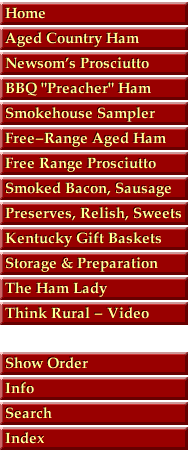
   Col. Nancy Newsom Mahaffey's Aged Kentucky Country Ham was one of three featured in a September article appearing in the New York Times. The Times article focused on the U.S. hams in a comparison with old-world prosciutto. Col. Nancy Newsom Mahaffey's Aged Kentucky Country Ham was one of three featured in a September article appearing in the New York Times. The Times article focused on the U.S. hams in a comparison with old-world prosciutto.Here are excerpts from that September 17, 2003...NY Times article... 'Taste My Prosciutto,' He Said With a Drawl By DANA BOWEN ...just a... few small commercial producers...still hang country hams for longer than six months, rendering the meat dark red and velvety with a complex flavor similar to that of prosciutto. ……… Country hams from the South never used to be eaten uncooked. Traditionally, they have been soaked to remove some of the salt from their cure, and then simmered in a sweet liquid like ginger ale, or even cheap Champagne, to neutralize the emphatic salinity. ..... "If you put a big, thick, salty slab of country ham on the plate here, people don't know what to do with it," said David Page, the chef and an owner of Home, a restaurant in the West Village in Manhattan, who toured Kentucky back roads for artisanal country ham (and bourbon) in November. "But when you shave it thin and describe it as American prosciutto, they begin to understand what it is." Mr. Page wraps tissue-thin, uncooked slices around sweet pickled watermelon rinds: a Southern rendition of Italy's prosciutto and melon. Candace Cansler, executive director of the National Country Ham Association, a trade association in Conover, N.C., said that the birth of interest in prosciutto-like uses of American country ham could not have been better timed. The production of country hams has held steady at six million annually for the last five to seven years, Mr. Cansler said. Many small producers have gone out of business, and large ones are making more hams than ever before. Until the 1950's, many rural Southern families slaughtered their own hogs and cured their own hams. Today, few Southerners can recall the savoriness of those country hams. With changing tastes, only the fiercest fans can palate the pungency of the once-coveted two-year ham — let alone the sight of it, furry with mold. All country hams are by definition dry-cured. But many now taste more like so-called city hams found in supermarkets — those that are brine-cured, sweeter-flavored and easy to cook. "Country ham has been stigmatized as a Southeastern food," Ms. Cansler said. "We're going to have to give it another name if we want to go for gourmet — something that suggests a prosciutto-style product." While in Italy the word prosciutto just means ham, to American country-ham producers it has come to symbolize the profit potential of their own products. "We've grown an average of 20 percent each year over the past seven years," said David Biltchik of Washington, who advises the Consorzio del Prosciutto di Parma, which accounts for 90 percent of the $50 million to $60 million worth of Italian prosciutto sold annually in the United States. .............. "We can learn a lot from our European cousins," said Sam Edwards, a third generation country ham producer. "They're selling their hams for $20 to $30 a pound." His hickory-smoked Wigwam Brand whole country hams on the bone, aged about a year, cost about $4.50 a pound. Joe Amadee, a distributor for Sermara Enterprises, an American company that sells Italian equipment used to salt and to dry prosciutto, said he has outfitted more than a half-dozen country-ham producers. "People who understand the prosciutto process realize it's pretty much the same as the country-ham process," he said. The Food Safety and Inspection Service of the Agriculture Department agrees. The same regulations govern all dry-cured hams produced in the United States, whether country or prosciutto style. Dry-curing with salt helps prevent bacterial growth, making the hams safe to eat uncooked. The regulations leave room for stylistic differences. Italian or domestic prosciutto is covered in salt for 10 to 14 days before it is hung to age, as compared with standard country hams' 35 to 50 days in salt. While imported prosciutto must age 400 days, the domestic equivalent generally ages nine to 12 months. Prosciutto is never smoked, like some of its country-ham cousins. The biggest difference between country ham and prosciutto is how they are eaten. Since country hams have always been cooked in the Southern states where they are cured, most country-ham producers do not consider them ready-to-eat meat like prosciutto. Thus, the Agriculture Department requires that labels on uncooked country hams contain safe-handling and cooking instructions. Nancy Newsom Mahaffey's country-ham business in Princeton, Ky., run by her family for 86 years, is old-fashioned: she salt- and sugar-cures just a few thousand nitrate- and nitrite-free hickory-smoked hams a year. Wolfgang Puck, Emeril Lagasse and other chefs have used her sweet-smoky speck-like hams. "My first market is Kentucky, which I consider a compliment," Ms. Newsom Mahaffey said, "but my second is California." For that second market, and for chefs who intend to use her ham uncooked, Ms. Newsom Mahaffey recently started selling her hams as Gourmet-Aged Prosciutto Ham, even though the label says the customer has to cook it. ................... |